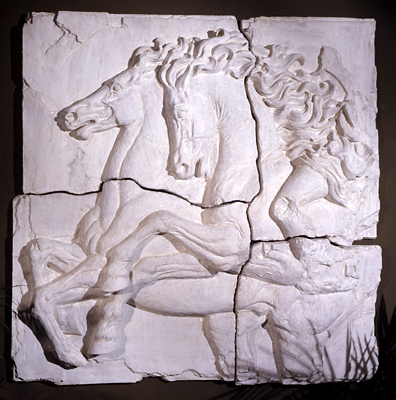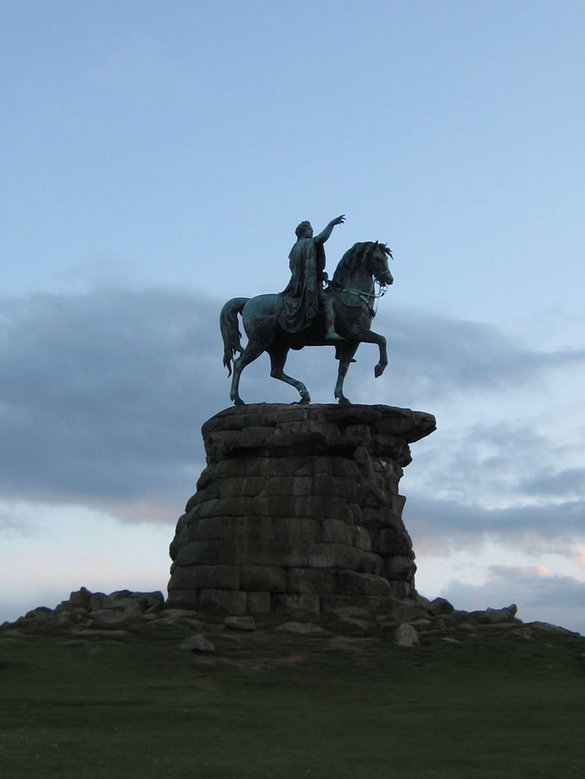Hand, Seat, Leg: Which Aid to Use?

Early in my practice of riding and training horses, there was one thing of certainty, obvious to me and the trainers I worked with and learned from. A horse who responded to leg cues alone, with little or no support from the reins, was a well trained horse. This was considered the ideal, and something various trainers have spent a great deal of time and effort attempting to develop and display.
To be perfectly honest, it’s really not all that difficult for many horses to learn what leg cues mean. In western riding, it’s customary the cueing is done with the outside leg, to remain unperceivable to the judge at the center of the ring. When I was a teen and preparing barrel racing horses, I preferred to have them curve their body around my inside leg, which suggested the position to take when moving around a barrel. This was seldom a difficult adjustment for the horse, despite having been formerly accustomed to outside leg prompts. For general riding, many styles of leg cues work well enough, and horses understand most simple maneuver requests.
However, what if one seeks something beyond simple? Some horses are natural athletes, and don’t need to be introduced to useful positions. However, for the more common horse, a bit of help from his human partner is welcomed and appreciated. What if the horse would be a better mover, with some collection? How about extension? How about horses that stumble over their front feet, and/or drag their hindquarters? How does one introduce the request, with legs, for the horse to gather himself, balance himself, and distribute his weight in preparation for a requested movement?
In these cases, the leg as primary, seat secondary, and hand tertiary is inadequate, a limited communication method. The leg is simply not able to introduce these kinds of requests from the rider to the horse, in a way he can understand. The horse’s resulting responses to our leg requests may range from apathy and indifference, to confusion, to frustration and rebellion, which can escalate to dangerous levels. Depending upon the tact of the rider and the sensitivity of the horse, responsiveness to ambiguous leg cues might be inconsistent at best.
At some point, the question has to be asked: who said the leg as primary was the best way? How would the horse respond, if the seat were primary, hand secondary, and the legs remain inactive? Experimentation reveals the answer. Shifting the focus of the aids to the seat as primary, with supporting hands and following legs, changes the horse’s ability to move and position significantly. No longer are the rider’s legs in the way, blocking the horse’s shoulder movement. In decent of the leg aids, the horse’s shoulders are free to reach and extend in ways simply not possible formerly. But, while movement becomes much freer, there is still a lacking ingredient, something impeding the ability to introduce a request to shorten the base of the horse for collection, and balance on all four legs. The seat is also inadequate to suggest a position….how about the hand?
Hand as primary, with a following seat and legs? But, isn’t that the basic stuff, we begin horses with? How can that also be the way to a finished a horse?
To be perfectly honest, it’s really not all that difficult for many horses to learn what leg cues mean. In western riding, it’s customary the cueing is done with the outside leg, to remain unperceivable to the judge at the center of the ring. When I was a teen and preparing barrel racing horses, I preferred to have them curve their body around my inside leg, which suggested the position to take when moving around a barrel. This was seldom a difficult adjustment for the horse, despite having been formerly accustomed to outside leg prompts. For general riding, many styles of leg cues work well enough, and horses understand most simple maneuver requests.
However, what if one seeks something beyond simple? Some horses are natural athletes, and don’t need to be introduced to useful positions. However, for the more common horse, a bit of help from his human partner is welcomed and appreciated. What if the horse would be a better mover, with some collection? How about extension? How about horses that stumble over their front feet, and/or drag their hindquarters? How does one introduce the request, with legs, for the horse to gather himself, balance himself, and distribute his weight in preparation for a requested movement?
In these cases, the leg as primary, seat secondary, and hand tertiary is inadequate, a limited communication method. The leg is simply not able to introduce these kinds of requests from the rider to the horse, in a way he can understand. The horse’s resulting responses to our leg requests may range from apathy and indifference, to confusion, to frustration and rebellion, which can escalate to dangerous levels. Depending upon the tact of the rider and the sensitivity of the horse, responsiveness to ambiguous leg cues might be inconsistent at best.
At some point, the question has to be asked: who said the leg as primary was the best way? How would the horse respond, if the seat were primary, hand secondary, and the legs remain inactive? Experimentation reveals the answer. Shifting the focus of the aids to the seat as primary, with supporting hands and following legs, changes the horse’s ability to move and position significantly. No longer are the rider’s legs in the way, blocking the horse’s shoulder movement. In decent of the leg aids, the horse’s shoulders are free to reach and extend in ways simply not possible formerly. But, while movement becomes much freer, there is still a lacking ingredient, something impeding the ability to introduce a request to shorten the base of the horse for collection, and balance on all four legs. The seat is also inadequate to suggest a position….how about the hand?
Hand as primary, with a following seat and legs? But, isn’t that the basic stuff, we begin horses with? How can that also be the way to a finished a horse?
9.23.2011 TME
return to
Educated Equestrian
return to
Educated Equestrian

“Upon these foundations is erected the art of bitting horses, which art, as far as it reaches, is sure and constant; but which, in spite of all the merit and praise of which it has so long been in possession, will, upon a serious and strict trial, never, I doubt, be found adequate to the views of a sound and intelligent horseman, nor capable of bringing a horse to that degree of suppleness, and exactness of carriage, which the truth and perfection of the art require. These attainments seeming to have been reserved for a more simple, but powerful machine, called the snaffle…..The bridle, in its collective sense, is that instrument, which principally enables the horseman to govern and guide the horse, so as to make him execute what he requires of him.”” A Treatise Upon Horsemanship, François Robichon de la Guérinière, French riding master, translated by W. Frazer, 1801.
“…the snaffle…principally enables the horseman…” Really? This little tool, we used at the beginning of training, is also the key to all higher equitation?
This is indeed the tool and text, used by the Spanish Riding School, to prepare the Lipizzaner stallions to Haute Ecole (High School, that is) levels. The one piece of equipment nearly every horse owner has hanging in their barn, is all one needs, to bring a horse from its beginning lessons to finish. The power of the snaffle lies not in its ability to exert physical leverage on the horse’s mouth; the power resides in its ability to communicate meaningfully to the horse a request for a position, which precedes a movement.
The educated equestrian understands the importance of the selection of the bit, as a communication tool, and its effects when considered together with that of the seat and leg. The three aids may be used together, or individually, at various points of training, but one thing always needs to be foremost on the rider’s mind: he needs to use a clear, meaningful and generous means of communicating with the horse, based upon that particular horse’s level of preparation and understanding. Ambiguous tools and aids cannot prepare the green horse. What I now recognize as certain, after considerably more practice, is that tools and aids of a basic nature can be understood by any horse at any level. When well presented, they can take the most basic work and make it sublime.
This is indeed the tool and text, used by the Spanish Riding School, to prepare the Lipizzaner stallions to Haute Ecole (High School, that is) levels. The one piece of equipment nearly every horse owner has hanging in their barn, is all one needs, to bring a horse from its beginning lessons to finish. The power of the snaffle lies not in its ability to exert physical leverage on the horse’s mouth; the power resides in its ability to communicate meaningfully to the horse a request for a position, which precedes a movement.
The educated equestrian understands the importance of the selection of the bit, as a communication tool, and its effects when considered together with that of the seat and leg. The three aids may be used together, or individually, at various points of training, but one thing always needs to be foremost on the rider’s mind: he needs to use a clear, meaningful and generous means of communicating with the horse, based upon that particular horse’s level of preparation and understanding. Ambiguous tools and aids cannot prepare the green horse. What I now recognize as certain, after considerably more practice, is that tools and aids of a basic nature can be understood by any horse at any level. When well presented, they can take the most basic work and make it sublime.